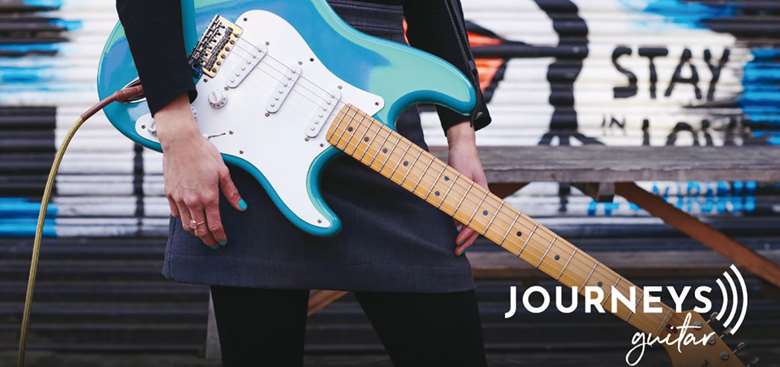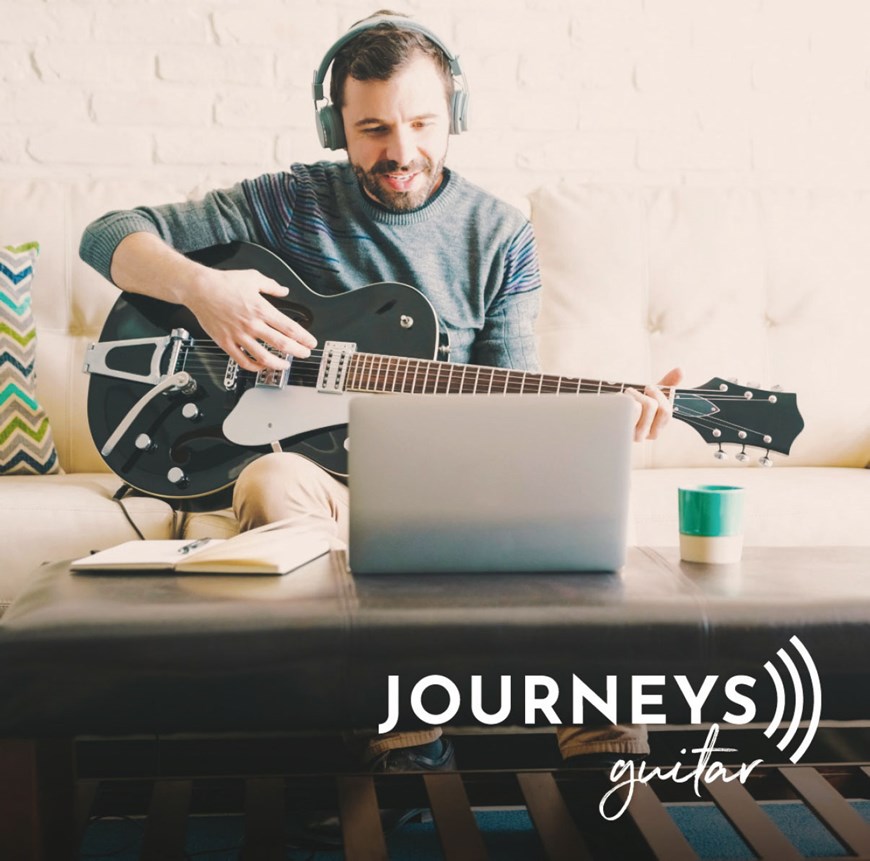Ready, steady, rock: ABRSM Guitar Journeys
Chris Walters
Tuesday, September 1, 2020
ABRSM's new guitar resource offers independent learners a pathway to rock and pop – but is this a route to successful strumming? Chris Walters finds out.

ABRSM, the leading international graded exam board, must be one of the most featured organisations in these pages – but not usually for a rock guitar product. Journeys, a new online resource that lets you play familiar pop hits on the electric guitar with a pre-recorded live band, marks a departure from the board's usual area of activity in three significant ways. Firstly, it is a standalone resource that does not link to an assessment. Secondly, it dives head-first into popular music, which ABRSM is not known for (its noteworthy jazz syllabus notwithstanding). And thirdly, it is designed for self-teaching learners, rather than learners who are working with teachers.
This premise makes Journeys an intriguing product to profile, and there is certainly a feeling when exploring it that the board is treading carefully. There was little fanfare when it launched last year; in fact, what first brought it to my attention was some online carping about ABRSM's promotion of a new product that, it was being suggested, bypassed teachers altogether. This eventually died down, and since then, Journeys seems to have been allowed to develop quietly, away from the spotlight.
It was Covid-19 that put Journeys back on my agenda. Logging on to the ABRSM website I noticed that, as a gesture to all the budding guitarists stuck at home during lockdown, the product was being offered as a 90-day free trial. (This trial period has now been reduced to 14 days, at the end of which a monthly subscription of £8.99, or £79.99 annually, is payable.) Housebound like everyone else, and with a neglected electric guitar in the cupboard, I felt it was the right time to give Journeys a go.
Getting started
Journeys has its own website (www.journeysguitar.com – there is no app) where you can find out the basics and set up an account. The idea is that you choose your favourite songs from the Journeys song library, and these become your own ‘journey’ as you work through them in order of difficulty. Notation and tuition videos are provided, and you can play along with the recorded band parts for that authentic gig feel when you are ready.
To begin, you are directed to a profile set-up page to input your card details for when the trial period expires. Next, the website steers you towards setting up your ‘pathway’, inviting you to choose two songs from a set of 34 that are graded ‘easy’. The songs are all from familiar artists – here are five chosen at random: One Direction, ‘What Makes You Beautiful’; The Rolling Stones, ‘Start Me Up’; MC Hammer, ‘U Can't Touch This’; Beyoncé, ‘If I Were a Boy’; and Bob Marley & The Wailers, ‘Stir it Up’. Then you are asked to choose two ‘medium’ songs from a list of 33, and two ‘difficult’ songs from another 33. Going through this process shows you the 100 songs that are available in total as part of Journeys – a list that is about as well-rounded as any set of 100 songs could be.

Having made your choices, you are presented with your own pathway. My pathway has 13 songs: the six I chose plus seven others. As the website explains, ‘The songs you've chosen are in the list but our experts have included some other tracks that will help you ramp up your skills along the way.’ It's not clear how the other songs are chosen; I suspect they are standard selections at set levels, rather than any clever algorithmic genre balancing.
High-tech learning
My first song is MC Hammer's ‘U Can't Touch This’. After clicking on ‘start learning’, I am presented with two video lessons, both covering the song's main riff with some minor variations addressed in the second lesson. The teacher, who is clear and concise, talks you through the riff and demonstrates it, and you can play along using the notation (including tab), which scrolls along under the video. By fiddling around with the menu options, you can also activate a live diagram of the fingerboard – a sort of animated tab – if you prefer that to standard notation. You can slow down the video and loop sections at your chosen speed for practice (I had to go into the settings to get the loop to play ad infinitum rather than just once). This really is an impressive piece of technology; looping and speed-changing are not new, but incorporating them into a guided learning process is, as far as I am aware.
There is also the option to ‘compare with the expert’, and you need to activate your device's mic for this. For me, this kind of feature is superfluous because you can hear if you are playing it right or not, and the software is unlikely to help you much if you are not; but I can imagine other learners getting a kick out of being told they are achieving precision. Once you've completed the lessons for a song, it is time to ‘take it to the band’. You can listen to the full performance or ‘replace the guitarist’. For the latter you need to activate your mic, which seems unnecessary as it would be fine just to play along without making a recording. That aside, this is another great piece of tech. The band are all on their own personal cameras, which makes you feel part of things, and the loop and slow-down features are still available.
Who is journeys for?
For starters, let's acknowledge that ABRSM has done well to avoid portraying the electric guitar as the domain of crusty male rockers. The various tutors and band members featured are a suitably diverse range of musicians – including female drummers – so hopefully no one will feel excluded.
Has my guitar playing improved because of Journeys? I have certainly got round some new songs and enjoyed some high-quality backing videos. Has my overall technique and understanding improved? Yes, in passing – but Journeys is not a guitar method. For me it is more of a digital, interactive repertoire book. It won't teach you the guitar, but it will certainly help.
Will self-teaching musicians be able to use Journeys? My answer is yes – as long as they are already quite advanced. I was surprised at the difficulty level of ‘U Can't Touch This’, which was supposed to be the easiest song on my pathway. In fact, I would put it at about Grade 2 due to the slides in the main riff. Clearly a Grade 2 piece is quite hard for a learner to launch straight into, and there is no video guidance on guitar tuning, posture, music reading or any other fundamentals. It looks like the Journeys blog (www.journeysguitar.com/blog) is going to be used for this sort of advice, but even so, blog posts are unlikely to be sufficient.
Ironically, the original online carping about teachers being bypassed by Journeys was, in my view, inaccurate, because most learners would benefit from a teacher guiding them through these materials. Indeed, I think Journeys itself is a little misguided about how far through it learners will be able to get without a teacher, but I can see it working magnificently as a resource in lessons with the teacher and learner using it together. If users do want to teach themselves from scratch, they will need a lot of other supporting information.
One thing I can't quite get my head round is the subscription model. The price is good value, but there is no indication that the 100 songs will ever be added to or updated. You can't download the materials, so I suppose the idea is that you subscribe in order to access them permanently. This feels unsatisfactory; with a subscription you should get new things every month.
To conclude, I really like Journeys and can imagine paying £8.99 a month until I can play most of the songs, after which the subscription might run its course. It is good to see ABRSM branching out in new directions, although I don't think the subscription model and platform are quite right – it feels a bit like some phenomenal materials obscured behind an unclear sales pitch. Perhaps some of the materials should be released for free or marketed better, as I don't imagine that many of Journeys' potential customers will have any idea about the quality of what's lurking behind the paywall.

